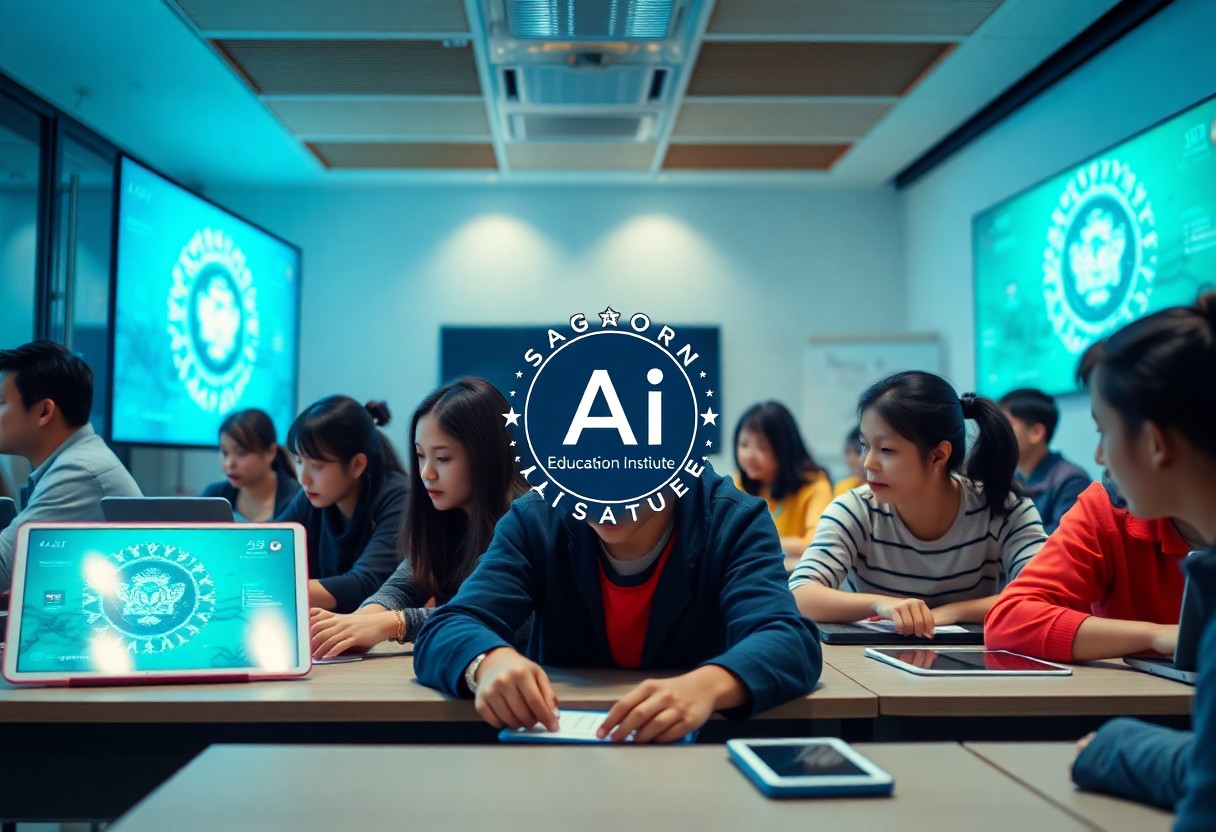Over the past few years, the landscape of education has undergone significant transformation, largely due to the rise of innovative technologies like Learnomics and artificial intelligence. These tools empower you to create a more personalized educational experience for students, tailored to their unique strengths and needs. In this post, we will explore five actionable steps you can take to leverage Learnomics and AI, enhancing your approach to teaching and ultimately elevating learning outcomes for your students.
Key Takeaways:
- Tailored Learning Experiences: Personalized education allows for customized learning paths that address individual student needs and learning styles.
- Data-Driven Insights: Leveraging Learnomics and AI provides educators with actionable insights derived from student performance and engagement data.
- Adaptive Technologies: Implementing AI tools can enhance the adaptability of learning materials, ensuring they align with the pace and preferences of each student.
- Enhanced Teacher Support: AI aids in reducing administrative burdens, allowing teachers to focus more on instruction and meaningful student interactions.
- Continuous Improvement: The iterative feedback loop facilitated by AI fosters an environment where educational strategies can be refined for better outcomes.
Understanding Personalized Education
Definition and Importance of Personalized Education
To understand personalized education, it’s crucial to recognize that it tailors learning experiences to meet the individual needs, strengths, and weaknesses of each student. This approach acknowledges that no two learners are alike and allows for customization in curriculum, instruction, and assessment. Personalized education aims to enhance student engagement and improve academic outcomes by catering specifically to your learning style and pace.
Besides providing a tailored educational experience, personalized education fosters a sense of ownership over your learning journey. When students feel their unique needs are considered, they are more likely to engage deeply with the material and develop a lifelong love for learning. This shift from a one-size-fits-all approach to a more individualized strategy highlights the evolving landscape of educational practices.
The Evolution of Educational Approaches
Education has come a long way from traditional methods that focused primarily on rote memorization and standardized testing. In recent years, there has been a notable shift towards more progressive and learner-centric approaches. The rise of technology, along with innovative teaching practices, has encouraged educators to rethink how they engage with students, paving the way for personalized learning models that cater to diverse educational needs.
Personalized learning represents a departure from conventional educational paradigms, embracing adaptive technologies and student choice. By incorporating various learning modalities—such as project-based learning, collaborative activities, and differentiated instruction—educators aim to create an environment where you can thrive. This evolution emphasizes the importance of flexibility in education, enabling you to take control of your academic journey.
Key Benefits of Personalizing Learning Experiences
An crucial aspect of personalized education is the numerous benefits it offers to students. When you engage in customized learning experiences, you are more likely to build intrinsic motivation and enhance your understanding of the material. Personalized learning strategies allow you to progress at your own pace, ensuring that you master each concept before moving on to the next. This method not only boosts confidence but also fosters a deeper connection with the subject matter.
Moreover, personalized education facilitates stronger relationships between you and your educators. With a tailored approach, teachers can provide more focused support, adapting their teaching methods to suit your learning preferences. This one-on-one interaction helps to create a positive and supportive learning environment conducive to your growth. As a result, the chances of academic success increase significantly, leaving you better equipped for future challenges.
Benefits of personalized learning extend beyond academic performance. They also contribute to developing critical life skills, such as self-regulation, goal setting, and problem-solving. By allowing you to take charge of your educational experience, personalized education cultivates a sense of independence and resilience that can carry over into various aspects of your life. Embracing these advantages can ultimately set you on a path to fulfilling your potential.
Overview of Learnomics
It is important to understand what Learnomics brings to the table in the education landscape. This innovative approach integrates the principles of economics, cognitive science, and technology to tailor educational experiences to individual learners. By examining how students learn and interact with content, Learnomics creates a dynamic model that adjusts to each learner’s needs, thereby optimizing their educational journey.
What is Learnomics?
On a fundamental level, Learnomics leverages cutting-edge technology alongside pedagogical principles to enhance personalized learning. It aims to bridge the gap between traditional education and the unique ways individuals absorb information. This model recognizes that each learner is different, ensuring that educational content is not only relevant but also engaging and accessible, greatly enhancing your ability to grasp complex concepts.
The Role of Data Analytics in Education
Learnomics harnesses the power of data analytics to transform the educational experience. By collecting and interpreting data on student performance, learning habits, and content engagement, it provides insights that can be used to fine-tune instructional strategies. This tailored approach enables educators to make informed decisions that can significantly impact your learning outcomes and experiences.
Role of data analytics extends beyond mere performance tracking; it is about creating an adaptive learning environment. By identifying patterns and trends in your learning behavior, educators can personalize resources, interventions, and support strategies that cater specifically to your needs. This not only optimizes your learning path but also fosters a deeper connection between you and the learning material, making education more relevant and effective.
How Learnomics Enhances Learning Outcomes
Role of Learnomics in enhancing learning outcomes is primarily attributed to its personalized approach. By evaluating your individual learning patterns, preferences, and challenges, this model equips educators with the tools needed to customize their teaching methodologies. This means that instead of a one-size-fits-all approach, you are given a tailored learning experience that actively engages you and meets your unique educational needs.
As a result, the educational environment becomes more inclusive and motivating, increasing your chances of success. When you are provided with resources and strategies designed specifically for you, the likelihood of grasping difficult concepts and achieving your academic goals significantly improves. It ultimately creates a more enjoyable and fulfilling learning experience.
It’s important to note that the integration of Learnomics is not a standalone solution but rather a collaborative tool that works alongside conventional teaching methods. By continually evaluating and adjusting based on data insights, it ensures that your learning experience remains dynamic, responsive, and ultimately more effective.
The Role of AI in Education
Keep in mind that the integration of AI in education is not just a trend, but a fundamental shift in how learning takes place. You will find that Artificial Intelligence can provide tailored learning experiences, tapping into individual strengths and weaknesses to enhance student engagement and success. In this digital age, the traditional “one-size-fits-all” approach is fading, making room for more dynamic and adaptive learning strategies.
Introduction to Artificial Intelligence in Learning
At its core, Artificial Intelligence encompasses a variety of technologies designed to mimic human intelligence processes. These can range from machine learning algorithms to natural language processing tools, all aimed at enriching the educational experience. AI algorithms can analyze vast amounts of data to provide insights into student performance, offering adaptive feedback that allows learners to progress at their own pace. This personalized feedback not only helps you grasp complex concepts but also fosters a more conducive learning environment.
Types of AI Technologies Applicable in Education
Intelligence in education is powered by several AI technologies, each serving distinct purposes to enhance your learning experience. Here’s a breakdown of key AI technologies you may encounter:
| AI Technology | Application in Education |
| Machine Learning | Personalizes learning paths based on student performance data. |
| Chatbots | Provides instant assistance and answers to student inquiries. |
| Natural Language Processing | Facilitates language learning and assessment through conversational interfaces. |
| Predictive Analytics | Identifies at-risk students and suggests interventions for improvement. |
| Intelligent Tutoring Systems | Offers tailored instructional support based on your learning progress. |
Learning with AI technologies not only enhances the quality of education but also empowers you as a learner. By utilizing these tools, educators can create more individualized pathways that cater to different learning styles and needs. Here’s a set of technologies to consider:
- Adaptive Learning Systems
- Virtual Classrooms
- Gamification Platforms
- Data Analytics Frameworks
- Augmented Reality (AR) Tools
Recognizing these technologies’ roles helps in understanding how AI transforms education into a more interactive and personalized experience.
Benefits of Integrating AI into Personalized Learning Environments
Environments that leverage AI are more capable of addressing your unique educational needs. AI can analyze your learning behaviors, preferences, and difficulties to suggest tailored learning modules that focus on your improvement areas. This level of personalization is merely a reflection of your individual learning journey and can significantly impact your educational outcome.
Integrating AI into these personalized learning environments creates opportunities for continuous feedback and assessment, allowing you to gain insights into your learning process. The adaptability of AI systems means that as you evolve, so does your learning plan, ensuring that obstacles are addressed promptly.
into the ever-changing landscape of education, AI not only crafts personalized experiences but also enhances motivation and retention. The engagement you experience through responsive learning strategies fosters a deeper connection with the material, ensuring that your educational journey is not just effective, but also enjoyable.
The 5 Steps to Revolutionize Personalized Education
Not only are you looking to improve education, but you are also ready to embrace the transformative power of Learnomics and AI. By approaching personalized education with a strategic mindset, you can create tailored learning experiences that directly address the needs of each learner. Let’s explore the five steps that will revolutionize how education is delivered and how students thrive.
Step 1: Assessing Learner Needs through Data Collection
Revolutionize your approach to education by starting with a thorough assessment of learner needs. Utilizing data collection methods allows you to uncover valuable insights into your students’ strengths, weaknesses, and preferences. This sets the foundation for informed decision-making, ensuring that personalized learning strategies are grounded in actual learner needs, rather than assumptions.
Collecting data can be accomplished through surveys, quizzes, and direct observations. By gathering information on their learning styles, interests, and past performance, you can tailor resources and approaches to enhance engagement and understanding within the classroom.
Step 2: Implementing AI-Powered Learning Platforms
At this stage, you will integrate AI-powered learning platforms that can analyze the collected data and provide actionable insights. These platforms leverage sophisticated algorithms to discern patterns in student behavior and learning outcomes, which allows you to deliver content that aligns with individual needs. The result is a more engaging educational experience that adapts in real time.
Tools such as adaptive learning systems, Intelligent Tutoring Systems (ITS), and other AI-driven applications not only enhance the learning experience but also free up your time as an educator. By automating certain processes, you can focus on facilitating meaningful interactions with your learners and providing support where it’s most needed.
Step 3: Designing Adaptive Learning Experiences
Above all, your goal should be to create adaptive learning experiences that evolve with each student’s progress. This approach employs flexible pathways that allow learners to advance at their own pace, ensuring they fully grasp concepts before moving on. Such learning experiences are supported by AI, which continuously assesses student performance and adjusts learning materials accordingly.
Offering various learning modalities—such as videos, quizzes, and hands-on projects—can accommodate diverse learning styles. By designing rich, adaptive environments, you help foster greater engagement and improvement among your students.
Step 4: Fostering Collaboration through Learnomics
Collection of data not only supports personalized learning but also promotes collaboration among students via Learnomics. By harnessing social learning opportunities and connections, you can introduce a collaborative environment where students learn from one another. This engagement improves peer interaction, critical thinking, and knowledge retention, while also building a sense of community.
AIPowered elements, such as collaborative tools and discussion platforms, can facilitate group projects or study sessions. These shared experiences contribute to enhancing the learning process, emphasizing cooperation in addition to individualized learning paths.
Step 5: Evaluating and Iterating Personalized Learning Strategies
Step into an iterative process by continually evaluating personalized learning strategies to ensure they remain effective. Regular assessments and feedback loops help identify areas where students might be struggling or excelling, allowing you to make timely adjustments as needed. This adaptive mindset is imperative to maintaining the relevance and impact of personalized education.
Step back and conduct reviews at intervals to assess the efficacy of your strategies and technologies. Gathering feedback from learners and analyzing performance metrics will provide insights that are invaluable for refining one-on-one instructional approaches.
Challenges and Considerations
Once again, as we investigate into the potential of personalized education through Learnomics and AI, it’s important to address the challenges that may arise when implementing these transformative technologies. While the benefits are substantial, various considerations can impact the successful integration of AI and personalized learning into educational settings. Understanding these challenges will prepare you to navigate potential obstacles, ensuring a smoother transition towards adopting innovative educational practices.
Overcoming Resistance to Change
Any initiative that seeks to change the status quo often encounters resistance. This is particularly true in educational environments where established routines and methodologies are deeply ingrained. You may find that educators, administrators, or even parents express hesitancy about shifting to a personalized learning framework. To combat this resistance, fostering a culture of openness and collaboration is crucial. Engaging stakeholders in discussions around the benefits of Learnomics and AI can help alleviate concerns and highlight the positive outcomes you can expect from these changes.
Another effective strategy involves offering professional development opportunities that focus on skill-building in using new technologies. By empowering educators with knowledge and showcasing successful case studies, you’ll help facilitate a more enthusiastic and informed adoption process. This can ultimately lead to a stronger commitment to personalized learning as everyone involved sees firsthand the potential benefits for students.
Data Privacy and Security Concerns
Among the top concerns surrounding the implementation of AI in education are data privacy and security. As personalized learning systems rely heavily on data collection, you must ensure that student information is handled with the utmost care. Increased reliance on digital platforms can lead to apprehension among parents and educators about how data will be used, stored, and protected. To address these concerns, it’s vital to establish clear policies regarding data privacy and security that align with regulations and best practices, fostering trust among all stakeholders.
Considering the sensitive nature of educational data, you should invest in robust security measures and regularly communicate your practices to parents and guardians. Transparency is key in alleviating fears related to data misuse, and maintaining an open dialogue about your data policies will demonstrate your commitment to student safety. This proactive approach can help to enhance the acceptance of personalized learning initiatives while emphasizing the need for ethical considerations in education technology.
Ensuring Equity in Technology Access
Behind every successful implementation of Learnomics and AI is the recognition that equitable access to technology is crucial. You must be mindful of the digital divide that exists in many communities, where disparities in access to devices and internet connectivity can hinder students’ opportunities for personalized learning experiences. To bridge this gap, consider developing strategies that provide resources and support for all students, ensuring they have equal opportunities to engage with innovative educational tools.
Technology access is vital for fostering a truly inclusive learning environment. By identifying challenges that specific demographics face regarding technology availability, you can initiate projects aimed at providing necessary resources. Collaborating with local organizations to create initiatives that target underserved populations is one way you can enhance accessibility and ensure that all students can benefit from personalized education opportunities.

Future Trends in Personalized Education
All around the world, the landscape of education is undergoing a transformative shift towards personalization, shaped significantly by advancements in technology. You can expect that the future of personalized education will be defined by data-driven approaches that cater to individual student needs, learning styles, and goals. As we look ahead, it is important to consider how these trends will evolve and how you can prepare to embrace the changes that will redefine the educational experience.
Predictions for the Next Decade
For the coming decade, the education sector is anticipated to see an increase in the adoption of AI-driven platforms that personalize learning experiences more deeply than ever before. You may find that students will have access to tailored curricula that adapt in real-time to their performance, offering challenges and support that suit their learning pace. Furthermore, the integration of virtual and augmented reality may allow students to immerse themselves in interactive learning environments, enhancing engagement and retention.
For educators and institutions, the predictive models developed through AI and machine learning will enable data analysis that informs educational strategies at a systemic level. These advancements will not only help you in understanding student progress in a more granular way but also assist in forecasting future learning outcomes, allowing for proactive interventions and support systems.
Emerging Technologies and Innovations
Technologies such as adaptive learning software, learning analytics, and AI tutors are expected to revolutionize the way educational content is delivered and consumed. You will likely experience personalized learning paths designed by algorithms that analyze your strengths and weaknesses, tailoring content specifically to enhance your educational journey. Additionally, the rise of gamification and interactive platforms will engage students in a manner that keeps them motivated and invested in their learning.
Hence, the ongoing development of such technologies promises a more engaging and customized educational experience. Tools leveraging machine learning will enable you to receive instant feedback, continuous assessment, and pathways that align with your interests and career aspirations, ensuring your education is as relevant and effective as possible.
The Role of Educators in Shaping Future Educational Landscapes
Emerging technologies will undoubtedly play a significant role in the future of personalized education, but the impact will also heavily depend on the educators driving these initiatives. You will find that as a teacher or educator, your role will morph from being a primary source of knowledge to becoming a facilitator who guides students through their personalized learning journeys. Your ability to curate resources and support students in navigating their individual paths will become a key aspect of your profession.
Consequently, as you adapt to an evolving educational landscape, professional development and continuous learning will be vital. You will need to embrace new technologies and approaches, equipping yourself with the skills to effectively leverage AI tools and advanced educational platforms. By doing so, you will be better positioned to inspire and empower your students, ensuring that they receive the personalized education they deserve.
Summing Up
On the whole, your journey towards revolutionizing personalized education begins with understanding the transformative power of Learnomics and AI in education. By embracing data-driven insights, you can tailor learning experiences that address individual needs, ultimately enhancing student engagement and academic success. By implementing the five key steps outlined, you will not only improve the efficacy of your educational practices but also empower you and your learners to take charge of the learning process in a way that feels personal and impactful.
As you move forward, keep in mind that the integration of technology and personalized learning is not a one-time event but an ongoing evolution. By continually analyzing data and adapting your strategies, your approach will remain relevant and effective. Engaging with both learners and educators throughout this process will ensure that you create a collaborative educational environment where everyone benefits from the advancements in AI and Learnomics. With commitment and focus, you can truly transform how education is delivered and experienced in your context.
FAQ
Q: What is Learnomics and how does it fit into personalized education?
A: Learnomics is an innovative educational framework that leverages data analytics and personalized learning techniques to enhance individual learning experiences. By analyzing student performance, preferences, and engagement, Learnomics tailors educational content and assessments to meet the unique needs of each student. This approach not only boosts engagement but also fosters a deeper understanding of the subject matter, making education more relevant and effective.
Q: How does AI contribute to personalized education in the context of Learnomics?
A: AI plays a pivotal role in personalized education through its ability to process vast amounts of data rapidly. In conjunction with Learnomics, AI algorithms analyze student behaviors, strengths, and weaknesses to provide customized learning paths. This enables educators to identify at-risk students, suggest relevant resources, and adjust instructional strategies on the fly, resulting in a more tailored and effective educational experience for each learner.
Q: What are the five steps to implementing Learnomics and AI in educational settings?
A: The five steps to effectively implement Learnomics and AI include:
1. Assessing current educational practices to identify areas requiring personalization.
2. Integrating learning analytics tools to gather data on student performance and engagement.
3. Utilizing AI algorithms to analyze the collected data and generate insights for tailored learning paths.
4. Designing personalized content, assessments, and intervention strategies based on the AI insights.
5. Continuously evaluating and refining the personalized approaches using feedback and ongoing data analysis to ensure optimal student outcomes.
Q: How can educators overcome challenges when adopting Learnomics and AI?
A: Educators can overcome challenges by prioritizing professional development, ensuring they are comfortable with the technology and understand how to integrate it effectively into their teaching practices. Collaboration among educators, administrators, and tech specialists is imperative for sharing best practices and troubleshooting issues. Additionally, involving students in the process can provide valuable feedback to further enhance the system’s effectiveness and engagement.
Q: What potential benefits can students expect from a personalized education approach using Learnomics and AI?
A: Students can expect multiple benefits from a personalized education approach, including improved engagement and motivation, as content and assessments are tailored to their interests and learning paces. This individualized focus helps students achieve a deeper understanding of materials and enhances retention. Furthermore, personalized education helps identify learning gaps earlier, enabling timely interventions and support, ultimately leading to better academic outcomes.




